Booster Seats
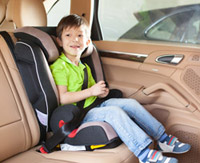
Once children have outgrown a group 1 forward-facing seat, they can use a group 2 or group 2/3 high-backed booster seat. Children using these seats are much less likely to be injured in a crash than children who are using seat belts on their own, or even worse, are completely unrestrained.
High-backed booster seats do not have an integral harness to hold the child in place. Instead, the car's seat belt goes around the child and the seat (except groups 1, 2 & 3 booster seats which have an integral harness which the child uses until they reach 18 kg in weight, when they should swap to using the car's seat belt with the booster seat).
The booster seat raises the child's seating position so that the car's seat belt fits them properly. If the seat meets the R44 standards, they have red indicators or slots to show where the seat belt should go. There is usually one at shoulder height to position the diagonal part of the seat belt and ones at waist height, often under the booster seat's armrests, to help position the lap part of the seat belt. If the seat adheres to the new i-Size (R129) regulation, these guides will be green.
The seat belt should go across the child's pelvis, chest and shoulder:
- The belt should be worn as tight as possible
- The lap belt should go over the pelvic region, not the stomach
- the diagonal strap should rest over the shoulder, not the neck
High-backed booster seats also have side wings that help to protect the child's head in an impact.
Some have an adjustable back or adjustable head rest, which can be raised or lowered to suit the height of the child using it.
Booster seats can be used in the front or rear of the car, but it is safer to put them in the rear, especially if there is a passenger airbag in the front.
It is safest to keep children in this type of seat until they have outgrown it. Only move your child to using the seat belt on its own once they have exceeded the maximum weight or height depending on the booster seat, or when the manufacturer's advice recommends that they are too tall for the seat (usually this will be when the top of the head extends above the back of the seat, but this can depend on the model of seat).
Types of booster seats
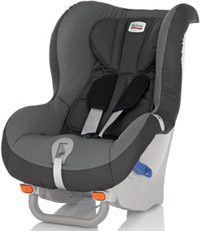
Group 2: for children weighing 15 - 25 kgs (33 - 55 lbs), roughly 4 to 6 years
Booster seats that only fit into Group 2 are less common. Most are group 2 and 3, or groups 1, 2 and 3
Groups 2 & 3: for children weighing 15 - 36 kg (33 - 79 lbs), roughly 4 to 11 years
These seats are adjustable to cover a wider range of weights and heights and so can last for several years. The child uses the integral harness in the seat until they are 18 kg or 25 kg on some seats (check the seat's instruction manual) and then uses the car's seat belt as with other booster seats.
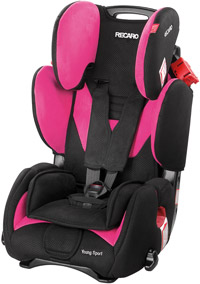
Group 1, 2 & 3 Combination Seat for toddlers and children from 9 to 36 kg (20 - 79lbs), roughly from 9 months to 12 years
These seats are adjustable to cover a wide range of weights and heights and so can last for several years. The child uses the integral harness in the seat until they are 18 kg, or 25 kg on some seats, (check the seat's instruction manual) and then the car's seat belt as with other booster seats.
Groups 0+, 1 & 2: for babies and children from birth to 25 kg (55 lbs), roughly birth to 6 years
These seats (which are not very common) are adjustable as the child grows and so can last for several years. They start rearward-facing up to 18 kg and are then turned forward-facing (they can be turned forward facing from 9 kg). The child uses the integral harness in the seat until they are 18 kg (check the seat's instruction manual) and then uses the car's seat belt as with other booster seats.
Fitting Booster seats
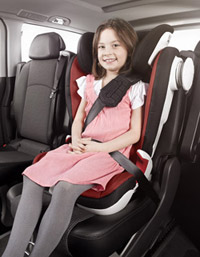
As with all child car seats, follow the manufacturer's recommendations on how to fit and use them, or visit our Child Car Seat Fitting and Compatibility page to access manufacturer video guides on how to fit your child car seat.
If you have a combination seat in which the child uses the seat's integral harness until they are big enough to use the car's seat belt, check the weight that seat manufacturer recommends the child swaps from the harness to the seat belt, and do not swap to the seat belt too early.
The seat belt goes around the child and the booster seat.
The seat belt should be threaded through the red or green guides or slots. There is usually one at shoulder height to position the diagonal part of the seat belt and ones at waist height, often under the booster seat's armrests, to help position the lap part of the seat belt.
The seat belt should go across the child's pelvis, chest and shoulder:
- The belt should be worn as tight as possible
- The lap belt should go over the pelvic region, not the stomach
- The diagonal strap should rest over the shoulder, not the neck
If the seat has an adjustable back or adjustable head rest, raise or lower this to suit the height of the child using it.
Booster seats can be used in the front or rear of the car, but it is safer to put them in the rear, especially if there is a passenger airbag in the front.
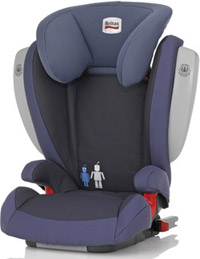
Isofix booster seats
Isofix seats booster seats have attachments built into them that slot into the Isofix anchorage points that are built into the car. The seat belt then secures the child in the booster seat as above.
Check whether your Isofix booster seat is approved for your car by contacting your car manufacturer and/or the child seat manufacturer; many have a list on their website that shows which seats are approved for which cars.
Photos courtesy of Britax and RECARO Child Safety Ltd
